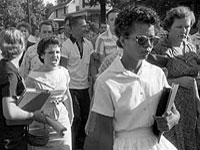Slavery and Manumission
Bridgette Houston, an African American interpreter at Colonial Williamsburg, discusses the process of manumission, by which slaves in colonial Virginia might be freed.
Bridgette Houston, an African American interpreter at Colonial Williamsburg, discusses the process of manumission, by which slaves in colonial Virginia might be freed.
Tom Spear, historical interpreter at Colonial Williamsburg's Governor's Palace describes the history of the building during its years in service, 1716-1780, and the political contributions of its occupants.
Gina DeAngelis, author of Colonial Williamsburg's interactive evening program, "The Gunpowder Plot," discusses the historical event on which the program is based. In the spring of 1775 in Williamsburg, VA, the royal governor of Virginia, Lord Dunmore, decided to remove the gunpowder stored in the Williamsburg powder magazine to prevent its being seized by colonists in the event of an uprising; the colonists learned about the plan, and the men sent to remove the gunpowder were met by armed militia. Click here to learn more about the gunpowder theft.
Colonial Williamsburg actor-interpreter James Ingram details the life of Matthew Ashby, a free black man who purchased his wife and two children in order to set them free.
Lady Dunmore, wife of Lord Dunmore (royal governor of Virginia from 1771 to 1776), was beloved by the colonists. Interpreter Corrine Dame reflects on Lady Dunmore's life.
Patrick Henry, orator of the American Revolution and first governor of Virginia, made his home at Scotchtown from 1771 to 1778.
The site offers exhibits and tours.

This collection of newspaper articles and photographs from two Arkansas newspapers explores the 1957 crisis in the city of Little Rock. National attention focused on the city when Governor Orval Faubus refused to allow nine African American students to desegregate the city's all-white Central High School, despite federal court rulings to the contrary. In response, President Dwight D. Eisenhower reluctantly became the first president since Reconstruction to send federal troops to protect the rights of African Americans.
Materials include news articles and editorials from each day of the month-long crisis, articles on the anniversaries from 1997 to 2000, and 16 photographs. In addition, material on the 40th anniversary of the crisis is provided: 19 op-ed pieces, speeches, an interview with President Clinton, timelines, and a 1991 defense by Faubus of his actions.
The Governor's Mansion is a 1842 Greek Revival Mansion which has served as Mississippi's gubernatorial residence since its erection. Most furnishings are Empire style (1810-1830), although the site also contains French Restoration (1830-1850), Rococo Revival (1850-1870), and Renaissance Revival (1860-1880) pieces.
The mansion offers period rooms and guided tours. Reservations must be made for groups of 10 or more. As the residence may be closed for state events, it is suggested that visitors call ahead to confirm that tours will be offered on the day which they wish to visit. The website offers small galleries of furniture images arranged by style, as well as floor plans.
Finished in 1913, Trail End was the home of the John B. Kendrick family. He was a cowboy who came up the Texas Trail in 1879, made his money in ranching and real estate, and later served as Wyoming's Governor and U.S. Senator. Trail End's Flemish Revival design and technologically-advanced interior are unique to the Rocky Mountain west. Today's visitors can enjoy 3.8 acres of groomed grounds (containing hundreds of indigenous and exotic trees) and a fully-restored historic house museum (mostly original furniture), plus regular productions at the Carriage House Theater.
A second website for this site can be found here.
The site offers exhibits, tours, educational programs, research library access, and performances.
This lecture explores Hiram Johnson's 1910 campaign for California governor and the reforms he instituted while in office. Johnson (18661945)'s work was praised by Theodore Roosevelt, and he would later serve as a senator.
To listen to this lecture, scroll to "Kick Out the Southern Pacific," and select "Listen to Broadcast."